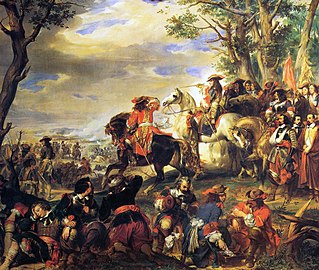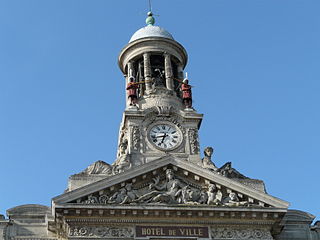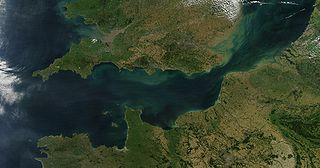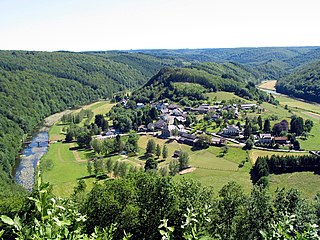
The Battle of Dettingen took place on 27 June 1743 at Dettingen on the River Main, Germany, during the War of the Austrian Succession. The British forces, in alliance with those of Hanover and Hesse, defeated a French army under the duc de Noailles. George II commanded his troops in the battle, and this marked the last time a British monarch personally led his troops on the field. The battle straddled the river about 18 miles east of Frankfurt, with guns on the Hessian bank but most of the combat on the flat Bavarian bank. The village of Dettingen is today the town of Karlstein am Main, in the extreme northwest of Bavaria.

The Battle of Malplaquet was a battle of the War of the Spanish Succession, fought on 11 September 1709, which opposed the Bourbons of France and Spain against an alliance whose major members were the Habsburg Monarchy, the United Provinces, Great Britain and the Kingdom of Prussia.

The Battle of Steenkerque was fought on 3 August 1692, as a part of the Nine Years' War. It resulted in the victory of the French under Marshal François-Henri de Montmorency, duc de Luxembourg against a joint English-Scottish-Dutch-German army under Prince William of Orange. The battle took place near the village of Steenkerque in the Southern Netherlands, 50 kilometres (31 mi) south-west of Brussels. Steenkerque is now part of the Belgian municipality of Braine-le-Comte.

The Battle of Krefeld was a battle fought on 23 June 1758 between a Prussian-Hanoverian army and a French army during the Seven Years' War.

The First Battle of Cape Finisterre saw 14 British ships of the line under Admiral George Anson attack a French 30-ship convoy commanded by Admiral de la Jonquière during the War of the Austrian Succession. The British captured 4 ships of the line, 2 frigates and 7 merchantmen, in a five-hour battle in the Atlantic Ocean off Cape Finisterre in northwest Spain. One French frigate, one French East India Company warship and the other merchantmen escaped.
The Battle of Madonna dell'Olmo or Battle of Cuneo was fought on the outskirts of Cuneo on 30 September 1744, in the War of the Austrian Succession. The battle ended in a victory for the armies of Spain and France over the Kingdom of Sardinia but it did not advance the victors' campaign.

The Battle of Rocoux was a French victory over an allied Austrian, British, Hanoveran and Dutch army in Rocourt, outside Liège during War of the Austrian Succession. The result was a major French victory but not the crushing blow French commander Maurice de Saxe had hoped to inflict.

The Battle of Friedlingen was fought in 1702 between France and the Holy Roman Empire. The Imperial forces were led by Louis William, Margrave of Baden-Baden, while the French were led by Claude Louis Hector de Villars. The French were victorious.

The Battle of Lauffeld, also known as Lafelt, Laffeld, Lawfeld, Lawfeldt, Maastricht or Val, took place on 2 July 1747, during the French invasion of the Netherlands. It was part of the War of the Austrian Succession. Marshal Saxe led the French forces against the Pragmatic Army, the combined forces of the British and Hanoverians under the banner of the Duke of Cumberland, and the Dutch Republic, fighting under the Prince of Orange, at Lauffeld, just west of Maastricht. Cumberland moved to defeat a detachment of the French army commanded by the Prince of Clermont that de Saxe had sent to bait the Pragmatic Allies into moving. Then Saxe force-marched the main French force to the ground he had chosen, thus outmaneuvering them.

The Battle of Marsaglia was a battle in the Nine Years' War, fought in Italy on 4 October 1693, between the French army of Marshal Nicolas Catinat and the army of the Grand Alliance under Duke Victor Amadeus II of Savoy.

The Battle of Torroella, also known as Battle of the river Ter, was a battle in the Nine Years' War, fought on 27 May 1694 along the banks and fords of the Ter River near the Puente Mayor in the vicinity of the important town of Girona, Catalonia, Spain.

The Battle of Carpi was a series of manoeuvres in the summer of 1701, and the first battle of the War of the Spanish Succession that took place on 9 July 1701 between France and Austria.

The Battle of Lagos was a sea battle during the Nine Years' War on 27 June 1693, when a French fleet under Anne Hilarion de Tourville defeated an Anglo-Dutch fleet under George Rooke. Rooke's squadron was protecting the Smyrna convoy, and it is by this name that the action is sometimes known.
The Battle of Elixheim, 18 July 1705, also known as the Passage of the Lines of Brabant was a battle of the War of the Spanish Succession. The Duke of Marlborough successfully broke through the French Lines of Brabant, an arc of defensive fieldworks stretching in a seventy-mile arc from Antwerp to Namur. Although he was unable to bring about a decisive battle, the breaking and subsequent razing of the lines would prove critical to the allied victory at Ramillies the next year.
The Battle of Emsdorf was fought on 16 July 1760 during the Seven Years' War at Emsdorf in present-day Hesse, Germany, between forces of British, Hanoverian and Hessian troops under the Prince of Hesse-Kassel against German troops in French service under Marechal de Camp von Glaubitz. It was part of the campaign to disrupt the French line of communications by capturing Marburg, a French supply depot.

The Battle of Pfaffenhofen was fought on 15 April 1745 between France and Austria. The Austrians under Karl Josef Batthyány defeated the outnumbered French under General Ségur, ending the war in Bavaria.
The Battle of Corbach, or Korbach, a Hanseatic town of Waldeck-Frankenberg in northern Hesse, Germany, was fought on 10 July 1760 during the Seven Years' War. Corbach was the first battle of the campaign of 1760 and was a victory for the French over the Hanoverians, the British and their allies.

The Siege of Bouchain, was a siege of the War of the Spanish Succession, and a victory for the French troops of the Duc de Villars. A French army of 20,000 men besieged and captured the Allied-controlled fortifications after an 18-day siege, with the 2,000-strong Dutch-Imperial garrison under Major-General Grovenstein capitulating on 19 October.






















